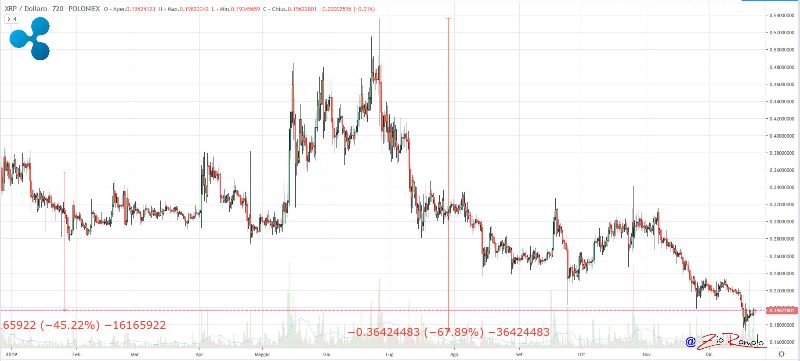Ripple (XRP) approaches the end of 2019 by closing its third fundraising a few days ago, on December 20th, which resulted in Ripple collecting more than $200 million. This brings Ripple’s overall valuation to $10 billion.
Ripple concludes a year that sees it very active in raising funds with further partnerships and acquisitions involving leading payment companies, but this has not positively affected the price.
2019 is XRP’s second consecutive bearish year. It is one of the worst performances among the big players. Ripple, on December 23rd, sees the value of the token lose more than 45% since January 1st. Only Stellar (XLM) is worse than Ripple with a decline of over 60%, as do IOTA and Dash losing 50% since the beginning of the year.
For Ripple, it was an important year that had started positively. In January and February XRP had overtaken Ethereum by total capitalisation, regaining second place in the overall ranking behind Bitcoin, an event that did not happen since 2015.
This was the year that saw the acquisition of both the cross-border transfer giant, MoneyGram, and the entry into RippleNet of the third similar company, used in the American and Asian markets, Real Money Transfer, a subsidiary of Euronet World Wide, which operates in over 150 countries around the world.
These two acquisitions by Ripple have not benefited the market in a positive way. Ripple, in fact, peaked in June when it exceeded 50 cents, which it had not touched since the end of 2018. Then throughout the second half of the year, Ripple’s value fell into a bearish trend that in mid-December 2019 brought it below 18 cents, to $0.1728, prices that Ripple had not recorded since the end of November and beginning of December 2017, making it lose more than 65% of its value from the high at the end of June.

If we take as reference the tops at the beginning of 2018, when Ripple’s token scored an all-time high at $3.3, the debacle of XRP from those levels to the lows of a few days ago marks a loss that goes beyond 94%, relegating it among the worst declines of the big names. Ripple is on par with Stellar who similarly loses 95% from the 2018 highs.
The only worse ones are Cardano with a loss of 97% and Bitcoin Cash which loses a few more decimals with a drop to date of 95%.
Ripple concludes a 2019 made of ambitions that, as repeatedly expressed by the CEO of the Ripple Foundation, aim to take over and replace the SWIFT payments network. This, however, also comes up against a decisive increase and adoption by the stablecoins.
Ripple, being a token that turns to financial institutions to perform cross-border transfers in real-time and with very low fees (a Ripple transaction costs less than a cent), competes with the issuance of new stablecoins, which to date are a hundred and which see financial giants such as JP Morgan or Goldman Sachs aspire to issue their own stablecoin instead of using Ripple or other cryptocurrencies.
This causes Ripple to struggle, despite the fact that during 2019 it has seen an improvement in its network, separating RippleNet, xRapid and xPring. xRapid, in addition to being a means of immediate value transfer, is a means of instant communication between the various financial and banking institutions.
In 2019 there was an increase in the number of companies that signed RippleNet network agreements, from 200 to around 300 entities. This has led to a sharp increase in financial transactions using XRP. On the other hand, the second half of the year, which is about to come to an end, saw a contraction in daily transactions despite an increase in the agreements made between several companies in the financial field for the use and adoption of XRP.
Ripple will begin 2020 with important expectations and with the ambition to regain the confidence that many XRP token supporters have lost during 2019. Last summer the strong loss of value of the token pushed some major XRP holders to threaten the RippleNet company to fork the same blockchain.
It should be remembered that about half of the total supply of the tokens already issued is in circulation, many managed by the Ripple Foundation. This is the reason why the price collapse has been repeatedly justified, both by CEO Brad Garlinghouse and by other Ripple members who claim to keep the token price low so that it can be easily sold and offered to financial institutions interested in using the RippleNet network.



